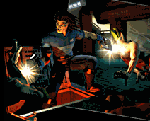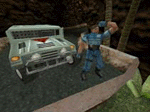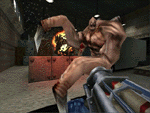 Sin is the latest First Person Shooter to hit
the market, following hot on the heels of Trespasser, Shogo-MAD, and Klingon Honor Guard.
To really stand out in a market like this, a FPS must deliver something that sets it apart
from the competition. So does Sin have that something extra that makes it worth buying
over other FPS shooters? Read on! Sin is the latest First Person Shooter to hit
the market, following hot on the heels of Trespasser, Shogo-MAD, and Klingon Honor Guard.
To really stand out in a market like this, a FPS must deliver something that sets it apart
from the competition. So does Sin have that something extra that makes it worth buying
over other FPS shooters? Read on! In Sin, you take the role of Colonel John Blade, leader of HARDCORPS. You
are on a mission to hunt down the source of the drug called "U4". As luck would
have it, while investigating suspicious ties to the SinTek Corporation you stumble on the
source of the "U4" drug. Upon further investigation, you find that Elexis
Sinclaire, SinTek's brilliant biochemist, is using the drug to accelerate human evolution
generations beyond its current rate. It's up to you to stop her and her minions.
One of the first things we noticed about Sin was its very long load times. Frankly, we've
been spoiled by fast loading FPS like Quake 2 and Shogo, and were kind of impatient with
the longer load times of Sin. We don't mean to complain too loudly, but we feel that the
developers should've optimized their code to minimize load times, especially since they
were using the very optimized Quake 2 engine. Another disappointment was the need for more
than 64MB of RAM; you won't get smooth frame rates without it, even though Quake 2 ran
very smoothly with 64 megs.
 When
we first loaded up the game, we weren't sure what to expect graphically. Since Sin uses
the Quake 2 engine, we wondered if it would to be able to compete with the visual effects
of Unreal. We were pleasantly surprised to find that the Quake 2 engine seems far more
capable than we expected. The game looks fantastic, from the extremely well done character
models for enemies and civilians to the look of the water in the fountains. The game also
includes excellent transparency effects for glass and water that give the game that
"real" feeling as you blast your way through each of the levels. The textures in
the game are nothing short of spectacular, and we would go so far as to say that they're
on par with Unreal's. Ritual also added a lot of other small graphical details that really
improve the gameplay, like leaving bullet holes in the walls, dropping quarters in
fountains that you can use in a pay phone, allowing you to get your pin number out of a
computer and use it at an ATM, and leaving money in a cash drawer at the bank. These small
details highlight Ritual's commitment to polish a game in a way other game companies often
don't take the time to do. When
we first loaded up the game, we weren't sure what to expect graphically. Since Sin uses
the Quake 2 engine, we wondered if it would to be able to compete with the visual effects
of Unreal. We were pleasantly surprised to find that the Quake 2 engine seems far more
capable than we expected. The game looks fantastic, from the extremely well done character
models for enemies and civilians to the look of the water in the fountains. The game also
includes excellent transparency effects for glass and water that give the game that
"real" feeling as you blast your way through each of the levels. The textures in
the game are nothing short of spectacular, and we would go so far as to say that they're
on par with Unreal's. Ritual also added a lot of other small graphical details that really
improve the gameplay, like leaving bullet holes in the walls, dropping quarters in
fountains that you can use in a pay phone, allowing you to get your pin number out of a
computer and use it at an ATM, and leaving money in a cash drawer at the bank. These small
details highlight Ritual's commitment to polish a game in a way other game companies often
don't take the time to do.
Sin's level design was excellent to say the least. The levels fit nicely with the story
and flow easily from one to the next without the annoying narrative gaps that other games
seem to revel in. Though the levels aren't always as large as you might expect, that's
because they're realistic. For example, the bank has both office and teller areas located
in different wings of the bank, locked doors on most offices, and a safe that can be
unlocked only after using a combination found in the main computer. The game has both
inside and outside levels, and the outside levels look much better running under the Quake
2 engine than Quake 2 ever did.
 The
sounds in Sin are another area in which Ritual has done its homework. We both were
impressed with the sounds and how well they fit into the gameplay. With the proliferation
of 3D sound cards in the past few months, games like Sin are really starting to utilize
their more advanced capabilities. From the very first level you notice sounds coming from
all directions, from the fountains in the bank to the screams of your fellow officers
pleading for your help, "Dammit I've been shot! Where the hell is Blade!" The
weapon sounds are on par with other FPS, but Sin does add some extra effects to the Quake
2 engine, such as echoing effects in hallways and machine gun shells falling onto floors.
Voice acting was a surprising plus as well; Blade's voice is deep as one would expect from
a Duke Nukem-inspired hero, while his sidekick, a computer hacker, has a younger sounding
voice. The
sounds in Sin are another area in which Ritual has done its homework. We both were
impressed with the sounds and how well they fit into the gameplay. With the proliferation
of 3D sound cards in the past few months, games like Sin are really starting to utilize
their more advanced capabilities. From the very first level you notice sounds coming from
all directions, from the fountains in the bank to the screams of your fellow officers
pleading for your help, "Dammit I've been shot! Where the hell is Blade!" The
weapon sounds are on par with other FPS, but Sin does add some extra effects to the Quake
2 engine, such as echoing effects in hallways and machine gun shells falling onto floors.
Voice acting was a surprising plus as well; Blade's voice is deep as one would expect from
a Duke Nukem-inspired hero, while his sidekick, a computer hacker, has a younger sounding
voice.
Since Sin uses the Quake 2 engine, you'd expect it to have fully functional multiplayer,
be it LAN or Internet. And indeed when the demo was released a month or so ago, the
internet play had already been implemented, which was a big plus. So does the full version
of SIN deliver? Well, let's just say it's like Quake 2. There really isn't much more to
SIN deathmatch than there is to Quake 2's, other than more textures on objects, which only
seems to slow down internet play. Don't get us wrong; it's cool that they included the
multiplayer support, but if you want a good deathmatching experience, go play Quake 2--if
only Ritual would have included a cooperative story mode, *SIGH*. on.
 --Jon Hall
& Tom Monter --Jon Hall
& Tom Monter
|

 Sin is the latest First Person Shooter to hit
the market, following hot on the heels of Trespasser, Shogo-MAD, and Klingon Honor Guard.
To really stand out in a market like this, a FPS must deliver something that sets it apart
from the competition. So does Sin have that something extra that makes it worth buying
over other FPS shooters? Read on!
Sin is the latest First Person Shooter to hit
the market, following hot on the heels of Trespasser, Shogo-MAD, and Klingon Honor Guard.
To really stand out in a market like this, a FPS must deliver something that sets it apart
from the competition. So does Sin have that something extra that makes it worth buying
over other FPS shooters? Read on!